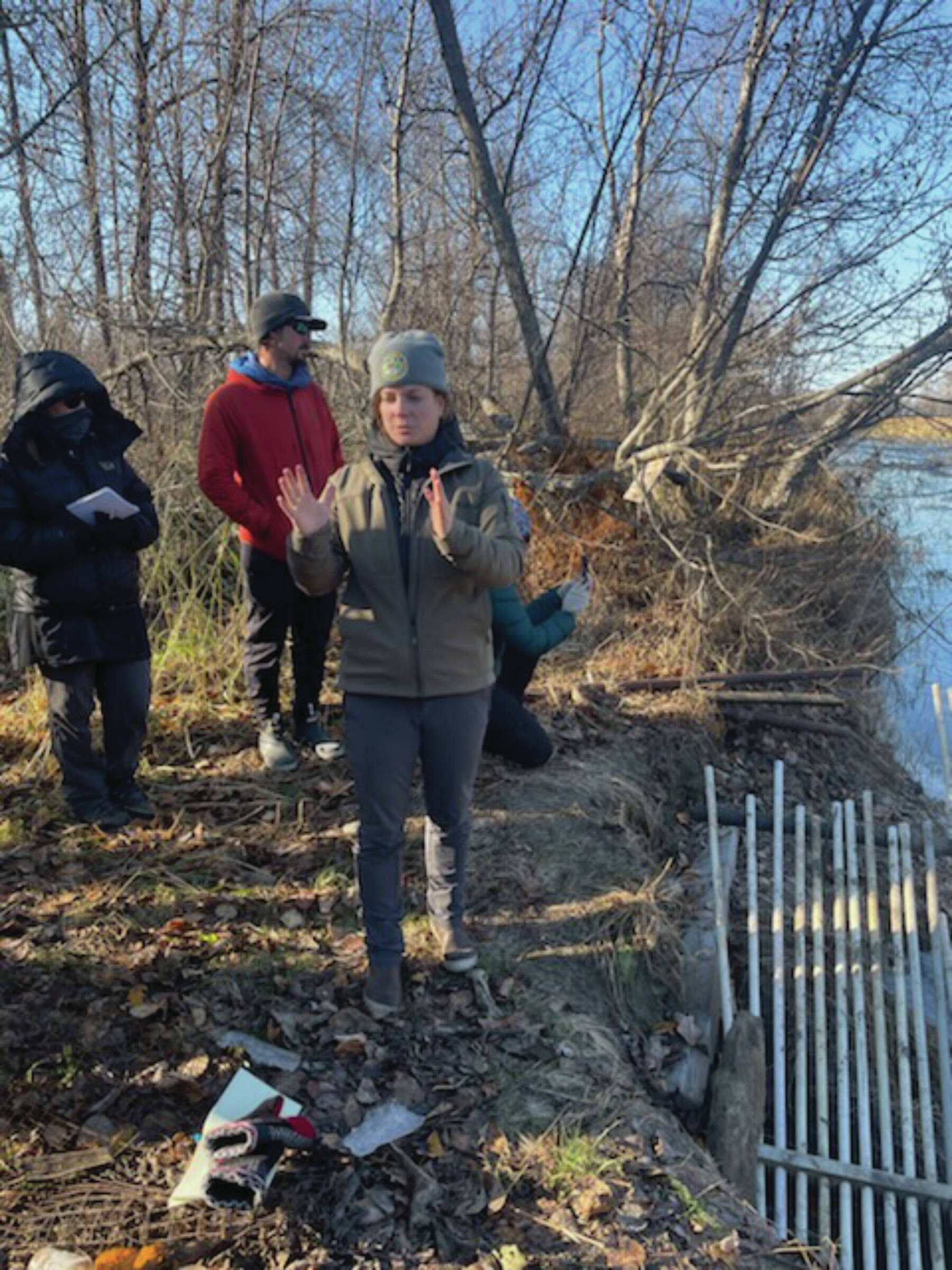The Kenai Peninsula and Southcentral Alaska chapters of Trout Unlimited are providing funding to keep the Alaska Department of Fish and Game’s Anchor River Weir open through the month of October in order to help collect more information on steelhead trout populations.
On Saturday, Oct. 19, Mike Booz, ADF&G area sportfish management biologist, along with assistant Holly Dickson, led a tour of the weirs near the Anchor River campground in Anchor Point. The old weir is slightly upstream of the Old Sterling Highway bridge and the new, functional one is located near the ADF&G research cabins. Several representatives of Trout Unlimited and local media attended the tour. The goal of the tour was to explain the operation of the weir and film system that monitors fish, in this case particularly for steelhead.
Dave Atcheson, Kenai special project assistant for Trout Unlimited, said the funding process began after he was approached by Anchor Point resident Lynn Whitmore at the Fish Habitat Partnership annual meeting in the fall of 2023. Whitmore wanted to know if it was possible for Trout Unlimited to put some financial efforts toward the extension of the summer weir season.
On Saturday, Booz began the discussion with participants by asking Whitmore, who was in attendance, why he thought updated information on the steelhead stock was important.
Whitmore has been engaged in the steelhead trout fishery since it was still open to harvest but now “the fishery has a very, very conservative fishery structure, probably one of the most conservative sport fisheries in the state,” Booz said. “The fishery is primarily catch and release with only a single hook and no bait.”
The fish are also restricted from removal from the water.
In response to the question, Whitmore responded that at one point, suggesting approximately 30 years ago, he was put on a local advisory committee with the Alaska Board of Fish to consider steelhead restrictions in lower peninsula streams. He said it was a long process and that there were many people who were in favor of actually stocking the rivers at that point, “but we held out strong for wild stocks,” Whitmore said.
“The board kept asking people, ‘why not just conserve what you’ve got to keep the river healthy?’ We just squeezed out a victory and eventually it caught on. The steelhead community would probably support us way more now than they did then,” Whitmore said.
Whitmore noted that anglers used to be able to participate in the fishery up until January but he pushed to end the season on Nov. 1 because of when the river starts to freeze and the “general lethargy of the fish in the colder water,” he said.
Whitmore said he approached Trout Unlimited last year because although “we think we know what we have in the river, we wanted to see if we can confirm it for a little longer.”
Due to the weir extension, Booz said, 2024 will be the first full steelhead count on the Anchor River. The catch and release season runs through the end of October.
He noted that one of the reasons for this in the past is that operating a weir on the Anchor River is very challenging.
“Even prior to statehood, when the feds oversaw these fisheries, no one wanted to run a weir in this river because the water level can be so flashy when you get rain or the spring snow melt,” he said.
Booz spoke about some of the other weirs on the rivers and explained how they’re used for chinook and coho salmon monitoring. Those upper river sites didn’t necessarily catch count of the steelhead due to their potential behavior to stay in the lower part of the river during the winter season.
Over the past few years, the run size has been somewhere from less than 1,000 to several thousand, Booz said.
For the Kenai Peninsula, Booz noted that the watershed habitat for the species is largely intact but the rivers do run along the road system where there are other industry projects like the gravel pits, “so we need to make sure the habitat stays that way, especially because we don’t entirely know where in the system the steelhead will overwinter.”
After talking with tour attendees, Booz led the group to the old weir site. The group then visited the new one downstream where ADF&G employees Danielle Siegert and Sarah Faris were busy removing ice from the weir.
Booz described the basic details of how the weir functions and the materials that it is created out of.
PVC pipes create small spaces that prevent fish from getting through except for one small section of the weir that is equipped with a glass screen, camera and motion detector — where a video image is collected of the fish as it swims through. The image is transmitted onto a screen back on the shore of the river. The device also uses pond lights so the video collected has a uniform quality 24 hours a day, Booz said.
The video files are also recorded to a computer that syncs to a One Drive folder and are available to be viewed immediately on screens in the ADF&G Homer office.
Booz noted that one of the disadvantages of this style of weir is that has to be installed in shallow water and collects more debris there than a weir placed in deeper water.
The final part of the tour showed the screen equipment housed in a shed next to the river. The screen is equipped with lines in order to measure the size of the fish that passes through the box.
Booz ended the tour with a general discussion of anadromous fish behavior, spawning and habitat preferences and how it varies depending on river characteristics and fresh water systems across the state, particularly referring to the lower Kenai Peninsula, Cook Inlet drainages and the Susitna tributaries. He noted that diversity within the various species contributes to sustainability over time.


